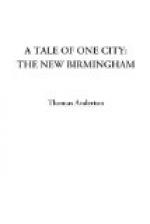It must, I think, have cost him a struggle to part company with such a man as Mr. Chamberlain—with one who had put him in the way he should go, and which led him to such a commanding position of influence and importance. Anyway, from whatever motive, he was induced to forsake the rising star in the political firmament, and to worship Mr. Gladstone, the setting sun. The sun went down below the horizon, but we saw how Mr. Schnadhorst continued to work his political orrery with the major and minor planets, the shooting stars and comets, that shone at Westminster with such varied lustre, or wished to shine there if they could.
VIII.
The Birmingham Belgravia.
Seeing how Birmingham has grown and prospered, it is interesting to consider what might have been the result if the town and its outskirts had not been fairly pleasant for well-to-do people to reside in. Fortunately, there is one extensive west-end suburb—Edgbaston—which forms a suitable, healthy, and desirable residential locality for the Birmingham upper classes. But for the existence of this well laid out—I was going to say genteel, but Heaven forbid—neighbourhood, a very large number of its wealthiest manufacturers and professional men would doubtless now reside some distance from the city. An increasing number of those who work in Birmingham now live—at least have their houses—outside its limits, owing to facilities afforded by the railways; but Edgbaston is still a rich, well-populated suburb within a very easy distance of the centre of the city. Mr. Schnadhorst, when he pulled political strings in Birmingham, regarded Edgbaston as a fine, good piece of vantage ground from an electoral point of view, since it kept so many rich residents within the pale of the town, and added so much to its influential voting power.
Edgbaston is chiefly, I might almost say entirely, the property of the Calthorpes, and the late Lord Calthorpe, also his predecessor, were wise in their day and generation, and they had agents who were shrewd and far-seeing. They saw the importance of reserving Edgbaston and laying it out as an attractive, quiet suburb, and the late lord at least lived to see it covered with leasehold residences, many of them—indeed a very large number of them—of considerable value and importance. When these leases expire, as some of them will now before many years are over, and the noble ground landlord begins to draw in his net, what a big haul he will make in the way of reversions of the properties that have been built upon his land!
Some of these Edgbaston houses are not only large and commodious, but are architecturally handsome and artistic. Birmingham has been fortunate during the last thirty or forty years in having two or three local architects who have not only possessed professional skill but also taste. The old square, solid, “money box” houses, so much esteemed by our fathers, are rarely erected now, but in their place residences of a more attractive design and artistic type.




